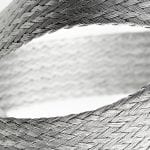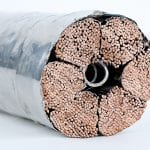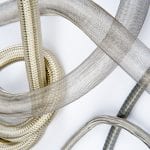Why Preformed Litz Wire Is Your Best Choice for High Current (kHz range) Magnetic Devices
With much of the electronics industry focused on designing for high efficiency and form factors that grow ever smaller, engineers increasingly design magnetic coils and windings to operate at high frequencies into the megahertz range. Higher frequencies create stronger magnetic fields and tighter coupling with less copper that fits into smaller physical spaces. This move to higher frequencies usually requires new chipsets, magnetic cores and other components suited for those frequencies. As a result, new winding topologies have come into the market. In particular, preformed Litz wire has become a preferred choice for HF magnetics due to its unique topology and construction. This article explains what Litz wire is, how it’s constructed, how it helps produce magnetic devices that are smaller, cooler and more efficient, and how the unique benefits of preformed Litz help engineers achieve the goals that modern electronics must meet.
To begin, Litz wire offers three substantial benefits in the design of such HF magnetic devices. First, magnetic devices using wound copper Litz wire operate more efficiently than those using traditional magnet wire. For example, in the low kilohertz range, efficiency gains compared to ordinary wire can exceed 50 percent, while in low megahertz frequencies, 100 percent or more. Second, by preforming Litz wire, the fill factor, sometimes called packing density, is dramatically improved. Litz wire is most often formed into square, rectangular and keystone shapes, enabling design engineers to maximize the Q of circuits and minimize losses and AC resistance of the device. Third, as a result of that preforming, devices using preformed Litz wire fit more copper into smaller physical dimensions than those using ordinary magnet wire.
These characteristics have established Litz as the preferred choice of design engineers across a wide array of products and devices for many years. Yet, accelerating growth in the electronics industry has popularized Litz wire, and preformed Litz in particular, even further.
Unparalleled Growth in Electronics
Innovation in artificial intelligence and robotics, autonomous vehicles for commercial, military and private use, advances in medical technology, computing and telecom, along with dozens of other marketplace segments have spawned a worldwide, accelerating demand for technology products.
Including the consumer, industrial and military market segments, electronics collectively accounts for a significant and growing portion of the nation’s—and even the world’s—gross domestic product. For instance, according to Consumer Technology Association (CTA)TM, the consumer sector alone directly generated $1.9 trillion in 2015, which directly accounted for 5.2 percent of the U.S. gross domestic product (GDP). A few more examples further illustrate the rapid growth of the electronics sector…
- Growth in India’s technology sector is anticipated to reach $1 trillion in the next several years, which includes $650 billion in hardware and Internet of Things manufacturing.
- The U.S. Department of Defense submitted a fiscal 2019 budget for $12.93 billion of electronics including military communications, telecommunications and intelligence technologies.
- With consumer spending increasing in developing countries, demand for electronic products also increases. In countries that produce electronic devices, growing competition drives the cost of production down, making those devices available to an even larger consumer market.
With this worldwide growth in electronics and the need to miniaturize while increasing copper density, coupled with the need to build higher Q inductors with nominal losses, the demand for preformed Litz wire is tracking along a similar growth trend.
Litz Wire 101
For those not familiar with the fundamental characteristics of Litz wire, consider these facts.
Its Origin
Litz wire gets its name from the German litzendraht, which means braided or stranded wire. Litz wire is made by weaving or twisting many thin strands of insulated wire together in a specific pattern. Litz wire was introduced and commercialized in the United States beginning in 1898 by New England Wire Technologies.
Essential Characteristics
Litz wire consists of a number of individually insulated magnet wires twisted or braided into a uniform pattern. In some Litz constructions twisted bundles are joined with other bundles, all of which are then twisted into the final product.
Litz wire’s unique twisting places each strand at the outside periphery of the conductor and at its center in equal measure. This unique twisting method, plus carefully selected wire diameter, gives Litz wire the ability to minimize losses from two sources: skin effect and proximity effect.
- Litz Reduces Skin Effect Losses. AC current flowing through a wire increasingly migrates toward the surface of the conductor as frequency increases. This skin effect increases the wire’s AC resistance in direct proportion to the frequency of the current. For example, with a 5 kHz current flowing through a conventional wire, the current density is largely confined to the outer 42.3 mils of the conductor, while at 100 kHz it flows only through the outermost 9.46 mils. These measures are known as skin depth. At frequencies up to a few megahertz, the AC resistance in a single conductor can be 20 or more times greater than a Litz wire of the same diameter, resulting in heat losses which, in high current applications, can compromise the device.
Designers can virtually eliminate the skin effect with Litz wire. The key is to choose the diameter of individual wire strands twisted into the Litz construction that are similar to the skin depth for the given frequency. Doing so causes current to flow through nearly the entire cross section of each wire, thus minimizing AC resistance and heat losses.
- Litz Also Reduces Proximity Effect Losses. An alternating current flowing through each conductor in a coil or winding creates an alternating magnetic field around it. That field induces eddy currents in adjacent windings, altering the overall distribution of current flowing through them and creating losses that manifest as unwanted heat. The result is that the current is concentrated in the areas of the conductor farthest away from nearby conductors carrying current in the same direction. This proximity effect increases with frequency. At higher frequencies, the proximity effect can raise the AC resistance of a conductor to as much as ten times its DC resistance.
The unique Litz wire twisting pattern places each strand nearly equally at the inside and outside of the cable, which equalizes the flux linkages and reactances of the individual strands. This causes the current to spread uniformly throughout the conductor. The resistance ratio (AC to DC) then approaches unity, which is especially desirable in high-Q circuit applications.
Basic Construction
Litz wire is made with individually insulated strands that may range from 28 to 48 AWG. Common magnet wire film insulations—polyvinylformal, polyurethane, polyurethane/nylon, solderable polyester, solderable polyester/nylon, polyester/polyamide-imide and polyimide—are normally used to insulate each strand.
The outer insulation and the insulation on the component conductors, in some styles, may be servings or braids of nylon, cotton, Nomex®, fiberglass or ceramic. Polyester, heat sealed polyester, polyimide and PTFE tape wraps along with extrusions of most thermoplastics are also available as outer insulation if the applications dictate special requirements for voltage breakdown or environmental protection.
Preformed Litz wire is initially constructed with a round cross section. Formed constructions are those in which the bundle of wire is reshaped and formed to create a geometry other than the original round construction. Special care must be taken to reshape the bundle without damaging the outer film insulation on the individual strands of wire. Typical shapes for formed Litz wire are rectangular, square and keystone.
Litz Wire Types and Constructions
Litz wire is manufactured in nine different styles. Types 4, 5 and 6 Litz wire constructions all utilize at least one inert core and are used primarily in tuning circuitry for high power radio transmitters. The smaller constructions of Litz wire, Types 1 and 2, are typically used in high Q circuitry such as toroidal coils and transformers. The larger Type 2 and Type 3 Litz wire designs have greater current carrying capacities necessary for high frequency power supply, inverter and grounding applications. Type 7 are braided and Type 8 are twisted and compressed/formed – both into a rectangular profile. Type 9 is a coax-style construction used to carry high frequency electrical signals with low losses and engineered to block signal interference. (Learn more here).
The high efficiency characteristics of Litz wire make it a preferred choice in the application areas listed here.
| Litz Applications | For Example... |
|---|---|
| Wireless Power Transfer | Vehicle Charging Systems |
| High Q Circuitry | Tuning Coils |
| Transformers & Torodial Transformers | Power Transformers |
| Inductors, Chokes | Solar Inverters, Motor Drives (VFDs) |
| Motors & Generators, Linear Induction Motors, Permanent Magnet Motors | Maglev Trains, Vehicle Propulsion, Oil & Natural Gas Drilling, Wind Turbines |
| High Frequency Power Supplies | Coils & Transformers |
| Inverters | DC to AC |
| Low Impedance Grounding | Industrial Machinery |
| DC to DC Converters | Electric Vehicles, Automotive, Medical Electronics |
| Induction Heating Coils | Induction Cooktops, Sealing Bottles, Mold Preheat Before Plastic Injection |
| Ballast | Fluorescent Lighting |
| Propagation of High Frequency Power Litz Lead Wire | Leads to Thin Film Deposition Equipment, MRI, Induction Heating |
| Flywheel Energy Storage | Energy Storage |
| Plasma Containment Coils | Stellarator, Fusion Experiments |
| Specialty Audio | High Fidelity Speaker Wire, Audio Interconnect |
Preformed Litz Wire
With Litz being manufactured in nine styles, Type 8 and Type 2 constructions are most often used to manufacture preformed Litz wire. Type 8 uses insulated strands that are formed into a square or rectangular cross section. The more economical Type 2 features bundles of twisted wires with each bundle again twisted together, then covered with an optional outer insulation. Both Type 2 and Type 8 can be formed into square, rectangular and keystone cross sections.
Type 2 is typically used in high Q circuitry, such as toroidal coils and transformers at frequencies up to around 1 MHz. The heavier gauge Type 2 designs have greater current carrying capacities necessary for high frequency power supplies, power conditioning, inverter and grounding applications. Type 2 is well suited for a wide range of uses and is rapidly becoming a first choice for magnetic device design.
Common Misconceptions About Litz Wire
- Litz wire cannot be soldered.
The majority of Litz wires are coated with an insulation using solderable polyurethane, solderable polyurethane/nylon or other coatings. For the few specialty Litz constructions that use high temperature enamel insulation, a number of simple processes allow for easy removal of the enamel that makes those constructions easily solderable. (Learn more here and here).
- Litz wire is difficult to specify for a given application.
Initially, there two key questions to answer in choosing the type of Litz wire best suited for a given application. First is the RMS current flow expected, which helps determine the wire gauge and construction used.
Second is the frequency to be used in the application. It’s important to choose a wire gauge for the individual strands that are comparable in diameter with the skin depth at the frequency to be used. The table illustrates how various frequencies map (roughly) into AWG wire diameters. However, when cost is an issue, using a lower cost, heavier gauge wire with a diameter up to about twice the skin depth seldom introduces significant losses below around 1 MHz.
| 60 Hz to 1 kHz | 28 AWG |
| 1 kHz to 10 kHz | 30 AWG |
| 10 kHz to 20 kHz | 33 AWG |
| 20 kHz to 50 kHz | 36 AWG |
| 50 kHz to 100 kHz | 38 AWG |
| 100 kHz to 200 kHz | 40 AWG |
| 200 kHz to 350 kHz | 42 AWG |
| 350 kHz to 850 kHz | 44 AWG |
| 850 kHz to 1.4 MHz | 46 AWG |
| 1.4 MHz to 2.8 MHz | 48 AWG |
However, these two factors do not identify the precise Litz construction needed. Further calculations are necessary to meet design goals for the project. Charles Sullivan (Dartmouth College) and Richard Zhang (MIT) offer a simplified approach for choosing the number and diameter of strands in Litz wire, and they show how to select the number of strands or sub-bundles to combine at each twisting operation.
Or, for more tailored help in selecting Litz wire, our Customer Engineering team can help specify the best Litz configuration for a given application. Such consultation often leads to discussion about the project; collaboration on the geometry of the coil; and, perhaps on the use of specific computer modeling software tools and other resources.
- Litz wire is too expensive.
While Litz is more costly than plain magnet wire, there are clear cases that call for Litz wire.
- The magnetic device will use high frequency AC. Litz wire minimizes the losses that occur at high frequencies. As noted above, many applications run from 50 to 100 percent more efficiently using Litz wire rather than ordinary magnet wire.
- The project calls for smaller, lighter weight devices. Using Litz, and especially preformed Litz, can reduce the size and weight of the finished device.
- Miniaturization is required. The real value of Litz becomes clear when the completed device is so efficient that the end product can be made smaller.
- Cost of ownership. Litz can contribute to reducing the end product’s long-term cost of ownership due to its greater efficiency in energy use.
- Battery-powered projects. The greater efficiency and low losses Litz delivers prolongs battery life. For instance, battery-powered electronics for the dismounted soldier need to run as efficiently as possible to continue operating over extended missions that may last up to 72 hours.
Preformed Litz has a small price delta when compared to round Litz wire. However, preforming gives an even smaller, lighter, more efficient device (calculated to be about 10% better area usage, energy efficiency, or a combination of both) than round Litz wire. If achieving a 10% gain in performance is significant in the application, the price uptick for preformed Litz will have little impact on build cost versus regular, round Litz.
Learn How Preformed Litz Wire Elevates Your Design
The manufacture of preformed Litz wire is a specialty that New England Wire has perfected after delivering round Litz constructions to the electronics industry for more than a century. In recent years the company has developed proprietary fabrication techniques that reliably process round Litz constructions into various cross sectional geometries—all without damage to individual strands or their insulation, and backed by the company’s extensive quality assurance programs.
Preformed Litz wire elevates your design not only by increasing the efficiency of your magnetic device. For engineering teams that use the “Design for Excellence” (DFX) approach, the use of preformed Litz wire can impact maintainability, manufacturability, economy, reliability and serviceability. Whether your magnetic device design challenge requires low losses, high Q, or small form factor, contact us and tap into our decades of knowledge.
Download a Printable Copy of this Content





















